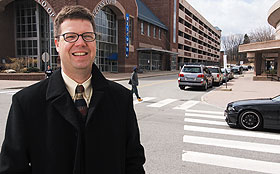  |
| HOME | THIS ISSUE | CALENDAR | GRANTS | BACK ISSUES | < BACK | NEXT > |
Professor puts landscape architecture skills to work for UConn campusby Karen A. Grava - April 13, 2009
|
||||
| A faculty member is both teaching his specialty and practicing it at the University. Mark Westa, a landscape architect and associate professor of plant science in the College of Agriculture and Natural Resources, spends half of his time on teaching and research and the other half working for the University’s administrative operations unit. “I practiced for 10 years professionally before I joined academe and I miss it,” Westa says. “But I also enjoy teaching and working with students.” The arrangement is advantageous to the University as well, since Westa is familiar with the campus, says Thomas Q. Callahan, associate vice president for administration and operations services. “Mark is the ideal individual to undertake several important projects that will help the University protect students, faculty, and staff, save money, and improve efficiency,” Callahan says. “Under this model, we are using faculty with expertise to provide assistance, rather than seeking outside consultants. It’s a model we would like to use in other areas as well.” Jim Bradley, associate vice president, says Westa has made an important contribution. “Mark has been especially helpful, because he combines the best of academic knowledge with practical know-how.” Westa is working on an access study of the Storrs campus, as well as a landscape master plan and site design manual. In short, he is helping the University decide how the campus will look and how it will function. “Landscape architects are trained much like architects,” he says. “Architects look at how people interact with space inside. Landscape architects look at how people interact with the world outside. We are interested in making places that are safe and function well, but also that add interest, beauty, and meaning to everyday life. ”One of his projects, for which the firm of Chance Management Advisors Inc. of Philadelphia was hired, is reviewing access management of the Storrs campus. The study includes how and when U.S. Postal Service, FedEx, UPS, Coke, 53-foot delivery trucks, and other trucks enter campus, cross sidewalks, and pull up to loading docks.
Sometimes there are so many trucks at the loading docks that they are three deep, waiting for their turn. “We’re concerned about the trucks interacting with pedestrians,” Westa says, “so we want to look at changing the routing of the trucks and perhaps the timing of the deliveries to increase efficiency and safety.” The project involves observing the deliveries and studying where roadways could be altered to protect students and other pedestrians. The landscape master plan will eventually include that information and other details that will help catalogue how the campus will look and function, he says. It may call for realignment of roads, limiting the number of crosswalks, or installing or moving sidewalks to make traversing campus safer. “Safety is our first concern,” he says. Another concern is attractive plantings that don’t require a lot of time to maintain. The plan will suggest landscaping that will be easy to care for, and will specify trees, plants, bushes, and other plantings that need minimum maintenance but provide maximum beauty. The study will also look at issues such as mowing and plowing, and recommend steps that can save time and money. Snow plowing is a major undertaking that is sometimes made more difficult because of a slope, the placement of a curb, or the width of a sidewalk, says Westa. Over time, adjustments will be made, “and, as we buy new equipment, we will phase in the equipment that is the most efficient.” Making all the changes in the plans will take many years, Westa notes. But the long-term results will provide a safer campus that is more efficient to run, as well as being more interesting and attractive.
|
| ADVANCE HOME UCONN HOME |

